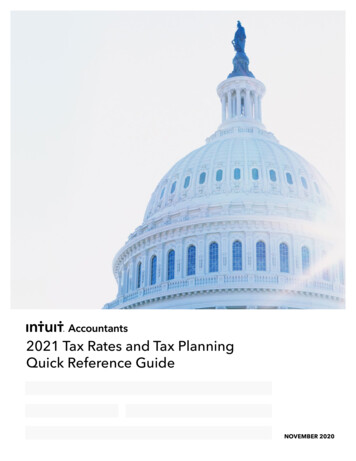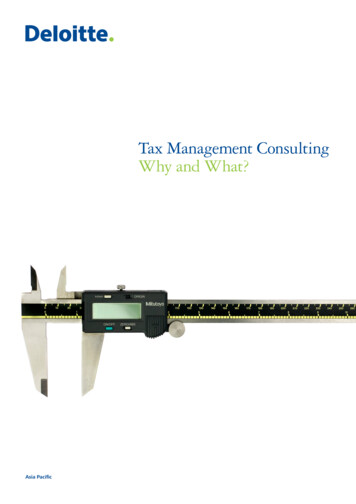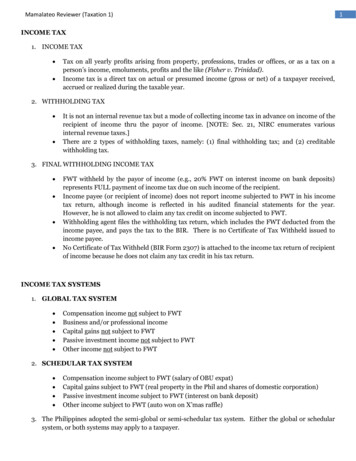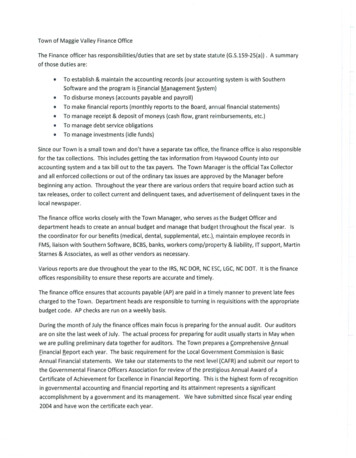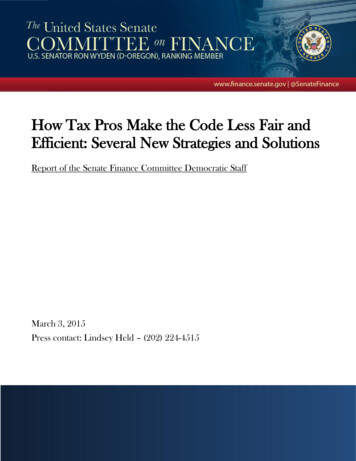
Transcription
How Tax Pros Make the Code Less Fair andEfficient: Several New Strategies and SolutionsReport of the Senate Finance Committee Democratic StaffMarch 3, 2015Press contact: Lindsey Held – (202) 224-45150
IntroductionHave you ever heard of a collar? Or a basket option? Or a wash sale? Most people haven’t. Butmany taxpayers use these sophisticated transactions to cut the taxes they could owe in half, oftenpaying effective rates far lower than people who earn a regular paycheck.This report describes each of these little known tax avoidance strategies identified for SenatorWyden by the nonpartisan staff of the Joint Committee on Taxation (JCT) and outside independentexperts, relying on memoranda, examples, and descriptions.1 A preliminary analysis indicates thatreforms to rein in some of these strategies could reduce the amount of taxes avoided by tens ofbillions of dollars over the next decade while making the tax code fairer and simpler overall.Certain taxpayers can use derivative contracts like options, forwards, and swaps to place bets onthe future values of stocks and other investments. 2 Unlike simply holding a stock for example,these taxpayers can tailor derivatives to lock in a stock’s gains (or losses) while also manipulatingthe timing of any taxes paid and minimizing the amount of tax that does get paid. Derivatives createtax wins for those who know how to use them, and it is all perfectly legal. The fact is that tax rulesand Treasury guidance have failed to keep pace with the multiplying varieties of tax avoidancestrategies that can be used to shelter income from taxation. The IRS also lacks the resources toproperly monitor and audit large partnerships that engage in these tax games, which allows thesetaxpayers to become even more aggressive in their use of such games to avoid taxes. Meanwhile,the vast majority of taxpayers can neither defer paying taxes nor minimize the amounts they dopay, and generally have to ride the ups and downs of the market on their investments.Unless cited otherwise, tax avoidance strategies and examples have been described to us by the staff of the JointCommittee on Taxation.2As a more formal definition, a derivative is a contract in which the amount of at least one contractual payment iscalculated from the change in value of something (or a combination of things) that is fixed only after the contract isentered into. The thing that fixes the payment amount(s) and hence the derivative’s value is called the underlying;examples include assets, liabilities, indices, and events. The most common forms of derivative are options, forwards,futures, and swaps. The taxation of derivatives has developed over a long period without a consistent underlyingpolicy. The tax rules apply differently depending on the form of the derivative, the type of taxpayer entering into it,the purpose of the transaction, and other factors. The rules are complex and may be uncertain in their application.(Source: Joint Committee on Taxation, Description of Certain Revenue Provisions Contained in the President’s FiscalYear 2015 Budget, December 2014, JCS-2-14). In the technical explanation of Ways and Means Chairman Dave Camp’sfinancial product reform discussion draft, JCT elaborated further on the above: “A derivative is (1) any evidence of aninterest in, or any derivative instrument with respect to, any (a) share of stock in a corporation, (b) partnershipinterest or beneficial ownership interest in a partnership interest or trust, (c) note, bond, debenture, or otherevidence of indebtedness, (d) certain real property, (e) actively traded commodity, or (f) currency; (2) any notionalprincipal contract; and (3) any derivative instrument with respect to any interest or instrument described above.”11
Tax Avoidance through Financial Products and Deferred CompensationBelow are the latest tax avoidance games that outside experts and JCT identified for SenatorWyden involving financial products or deferred compensation. (Also, included at the end of thisreport is some general background on income taxation and types of derivatives).1. Using “collars” to avoid paying capital gains taxes. Taxpayers who own appreciated stocksmay lock in the gain by using a “collar” that involves purchasing simultaneous options to buyand sell the stock at set prices to hedge against any stock price fluctuation. In this way,taxpayers are able to lock in a capital gain while bearing little economic risk for a change invalue in the security and without constructively selling it. If there is no constructive sale thenno capital gains taxes are owed. Congress tried to address this practice back in the 1990s byforcing taxpayers to recognize gains on securities that were entirely hedged using suchderivative transactions, but Treasury never followed through with writing and enforcingregulations regarding options and collars.Example 1:3 A taxpayer owns 100,000 shares of XYZ stock which is currently trading at 100per share. The taxpayer now purchases a type of option called a “put” from a bank whichallows the taxpayer to sell 100,000 shares of XYZ to the bank in three years for 10 million. Atthe same time, the taxpayer sells a “call” option to the bank, which gives the bank the right topurchase 100,000 shares from the taxpayer in three years for 11 million.4 Thus, in thisexample, the taxpayer locks in 10 million of sale proceeds and, potentially, may receive 11million.5 But the taxpayer avoids paying any tax now even though it has locked in the income.6By comparison, a married couple earning 100,000 might pay a 25 percent income tax rateplus a 15.3 percent payroll tax rate (which counts the employee plus employer portions) onthe wages they receive, or a combined 40.3 percent tax rate7 on each additional dollar ofwages.2. Using wash sales to time the recognition of capital income. A central tax challenge posed bythe current treatment of capital gains is that such gains are only taxed when realized. Thus,Provided by Steven Rosenthal, Senior Fellow, Urban Institute, Washington, DC.In addition, the options may be physically or cash settled. So, if XYZ is trading at 130 on the settlement date, thetaxpayer may either deliver the 100,000 shares of XYZ to the bank in exchange for 120 million or make a cashpayment of 1 million (i.e., the difference between the 120 strike price and the 130 market price of XYZ on the dateof settlement multiplied by the number of shares underlying the option).5 The collar in this example is a 10 percent collar in that the 11 million strike price for the call option (the right forthe bank to purchase the shares) is 10 percent higher than the 10 million strike price for the put option (the right forthe taxpayers to sell the shares). Treasury Department guidance that accompanied the enactment of the constructivesale rules in tax code section 1259 suggested that any collar below 15 percent was abusive, but additional guidancefrom Congress or Treasury is still needed.6 In addition, the taxpayer in this example could in three years, defer the tax further by settling the option in cashrather than physically acquiring the underlying asset. The taxpayer might extend its contract, but the extension couldbe a taxable event (the extension issue is being litigated in the tax courts now).7 The effective tax rate is actually slightly less than 40.3 percent because employers get to exclude the employerportion of payroll taxes from employees’ taxable incomes.342
taxpayers can defer realizing capital gains but can realize capital losses at will withoutchanging their economic position, by terminating a security that has lost money at the end ofthe tax year and then immediately repurchasing a substantially similar security. While sellingthe first security triggers the realization of the loss, purchasing the second security does notundo this loss realization.In this way, some taxpayers can selectively recognize losses to offset capital gains income thatwould otherwise be taxed and then perpetuate the same loss position to offset gains at anothertime – thus, they effectively pay no taxes on the capital gains they do realize. While current“wash sale” rules do prevent taxpayers who sell securities at a loss from recognizing the loss ifthey acquire a substantially identical security within 30 days of the first loss sale, these ruleswere not designed to recognize similar games played with more modern financial instrumentslike forward contracts and swaps (which obscure constructive sales of the underlying security)and do not apply to other assets like commodities and currencies.Example 2:8 A taxpayer owns a portfolio that contains stocks with unrealized gains and stockswith unrealized losses. The taxpayer would like to realize the losses to offset other income.So, the taxpayer sells the losing stocks in the market and, at the same time, enters into aderivative contract with a bank. Under the derivative, the bank pays the taxpayer theeconomic-equivalent return of the stocks that have been sold plus the return of additionalstocks that the taxpayer was planning to buy. Because the derivative references a basket ofstocks that is somewhat different from the stocks that have been sold, the taxpayer can takethe losses on the stocks that have been sold. After 31 days, the taxpayer terminates thederivative and rebuys the stocks that had been sold. After these transactions, the taxpayerowns the same portfolio she had previously, but she now has income losses that reduce hertaxable income and thus her tax bill and she does not have to pay tax on her stock gains.By comparison, the married couple on a 100,000 salary would pay a 40.3 percent total taxrate on that earned income. To the extent these taxpayers have capital income, they would paycapital gains taxes (a 15 percent rate for the example), most likely on gains from mutual fundinvestments rather than on individual stocks or commodity and currency derivatives. It wouldnot be economically feasible for typical taxpayers to enter a derivative contract with a bank tosuccessfully skirt existing wash sale rules and avoid paying capital gains taxes on the securitiesthey own.3. Using derivatives to convert ordinary income to capital gains or convert capital losses toordinary losses. Taxpayers trigger capital gains taxes through the sale or exchange of capitalassets. However, if contracts on capital assets are held to maturity, the income flowing fromthe contracts will usually be taxed at ordinary rates even if the character of the income fromthe property that is the subject of the contract is capital. Derivatives such as swaps are8Provided by Steven Rosenthal, Senior Fellow, Urban Institute, Washington, DC.3
property: they are contracts between two parties in that they confer a right to receive or makea payment based on the price of a security at a set future date. Even while the underlying assetreferenced by a swap might have a capital gain, the payments required by the derivativescontract are generally taxed as ordinary income if the contract is held to maturity.9 However, ifthese contracts are terminated before maturity by a sale of the underlying asset, then theproceeds are generally treated as a capital gain (or loss). Because these swap contracts can beused to toggle the character of the underlying investment to maximize the tax benefit –terminating the derivative early to generate capital gains or losses or holding it to maturity togenerate ordinary income or losses – some taxpayers can use them to significantly alter whenthey pay taxes and at what rates.10 By contrast, typical wage earners must pay income tax plusthe employer and employee portions of payroll taxes out of every paycheck. Such taxpayers donot have the choice of when to pay taxes or at what rate, and do not have access to these typesof financial products or the related tax planning advice. The fees to enter into thesetransactions are prohibitive for most taxpayers.4. Using derivatives to avoid constructive ownership rules for partnership interests.11 In the1990s, some taxpayers purchased swaps (or other derivative instruments) mimickingownership of an investment partnership rather than directly purchasing an interest in saidpartnership. Taxpayers used such tax games to report long-term capital gain (taxed at 23.8percent today), rather than the ordinary income and short-term capital gain (taxed at 43.4percent today) that would have resulted from ownership of the actual partnership interest. In1999, Congress tried to end this practice by limiting (in tax code section 1260) the amount oflong-term capital gain a taxpayer could recognize from derivative contracts that referencedpartnership interests as the underlying asset. Congress identified “constructive ownership”transactions as swaps, forward contracts, option collars, and, to the extent Treasury providedin future regulations, other transactions with substantially the same effect. Unfortunately,Treasury never wrote these regulations, so some taxpayers continue to use derivatives oninvestment partnerships that mimic ownership of an interest while avoiding the higher taxliability that goes with actual ownership.Example 3: On January 1, 2012, a taxpayer entered into a “deep-in-the-money” three-yearoption contract12 with a securities dealer with respect to a partnership interest. Under theNote that for forward contracts and so-called bullet swaps (swaps in which a single payment is exchanged atsettlement, similar to a forward) the final payment at maturity would be treated as long-term capital gains if theunderlying asset is capital under proposed regulations for tax code section 1234A. Some believe the proposedregulations have sufficiently discouraged taxpayers from using these derivatives to toggle gains and losses.10 Note that individual investors who enter into derivative contracts cannot usually deduct ordinary paymentsbecause of the limitations on miscellaneous itemized deductions (section 67 of the tax code). Capital losses ofindividuals also are limited to 3,000 against ordinary income). But taxpayers like hedge funds that buy and sellfinancial instruments in the course of a trade or business generally can fully deduct ordinary payments.11Provided by Steven Rosenthal, Senior Fellow, Urban Institute, Washington, DC.12 A deep-in-the-money option is an option with an exercise price, or strike price, significantly above (usually at leasttwice the value of) the market price of the underlying asset (for a put option in this example). For example, if the94
terms of the option, the dealer agrees to pay the taxpayer the difference between the marketprice of the partnership interest and the “strike” price of the option (i.e., the price at which theoption can be exercised) at the settlement date of January 1, 2015. Suppose the partnershipinterest was initially worth 200, but the strike price on the option was 100 (and the taxpayerpaid 100 for the option, which is her basis). Also, suppose at settlement, the partnershipinterest is worth 400. By holding the option as opposed to holding an actual partnershipinterest, the taxpayer gets to treat the 300 payoff ( 400 minus 100) as long-term capital gainin 2015, taxable at 23.8 percent instead of receiving a gain of just 200, taxable at 43.4 percent.(The taxpayer also does not recognize any short term gain or ordinary income – and therefore,no tax liability – before the 2015 settlement date).Typical taxpayers do not own interests in partnerships or have access to derivative contractsthat enable them to convert capital gains income into ordinary income. The married coupleearning 100,000 from the previous example would pay a 40.3 percent tax rate on eachadditional dollar of income – or nearly twice the tax rate as the taxpayers who make use of thisparticular tax game.5. Using “basket options” to convert short-term gains into long-term gains. A number of hedgefunds have used a complex financial structure to convert short term capital gains (taxed at43.4% today) to long-term capital gains (taxed at 23.8%). The strategy uses a combination ofoptions called colloquially “basket options.” Clearly a tax shelter, basket options purportedlyallow ultra-high income investors to reduce their tax bill below that required by current law.13Basket option transactions occur between hedge funds and banks. A bank establishes anaccount in its own name or that of a subsidiary. This account is used to maintain a portfolio ofsecurities, making the account a “basket” of securities. The bank then enters into a “basketoption contract” with a hedge fund. As the option holder, the hedge fund may exercise theoption and receive a payoff equal to the profits generated by the basket of securities.Though the account and the securities within it are technically owned by the bank, the hedgefund acts as an investment advisor and manages the assets within the account. The bank setsseveral basic parameters but otherwise gives the hedge fund wide discretion as to thecurrent price of the underlying stock were 10, a put option with a strike price of 20 would be considered deep-inthe-money. Arguably, a deep-in-the-money option is little different from a constructive sale because the holders ofsuch options are highly likely to exercise them.13For example, in July of 2014, the U.S. Senate Permanent Subcommittee on Investigations of the Committee onHomeland Security and Government Affairs published a report titled “Abuse of Structured Financial Products:Misusing Basket Options to Avoid Taxes and Leverage Limits.” The report detailed the arrangements under whichhedge funds collaborating with Deutsche Bank AG and Barclays Bank PLC – the institutions selling the so-called basketoptions – were able to amass over 35 billion in trading profits, of which 34 billion came from options exercised aftermore than one year and taxable at the lower long-term capital gain rate even while the underlying assets weretypically held for less than one year (and sometimes for even as short a span as a few minutes) and normally taxableat higher ordinary income tax rates.5
investment strategy. Profits remain in the account until the option is exercised. The value ofthe option rises as the value of the assets in the account rise. When the hedge fund exercisesthe option, it collects the profits associated with the account. The bank profits by collectingfees from the hedge fund.By characterizing the transaction as a derivative, a hedge fund is able to defer gains and lossesfrom high-frequency trading and recast short-term capital gains as long-term capital gains.This is because the trading account (the basket) serves as the underlying asset for thederivative, not the assets within the account (which are a larger sum and often includeleveraged amounts); so the value of the basket determines the value of the derivative, and notthe actual value of the assets in the basket. A derivative is not taxed until a realization eventoccurs. Realization occurs when the hedge fund exercises or sells the option. Thus, when thehedge fund waits 12 months before exercising or selling the option, gains on the option will belong-term capital gains, taxed at 23.8 percent. Had the hedge fund directly traded the assetswithin the basket, the holding period for almost all of the assets would be less than 12 monthsand gains from the assets would be taxed as short-term capital gains, which are taxed asordinary income at a marginal rate of 43.4 percent today. Banks entering into thesetransactions usually set three-year terms on their basket options, though hedge fundsgenerally exercise their options a little over 12 months after entering into them.In 2010, the IRS issued an Office of Chief Counsel Internal Revenue Service Memorandum(Generic Legal Advice Memorandum (GLAM) 2010-005) – an internal memorandum providingthat these basket options were not options at all, but rather an account of securities owned bythe hedge fund. Accordingly, profits from trades of assets held for less than a year would besubject to the higher short term capital gains rate. Unfortunately, GLAMs have no legalauthority and hedge funds – and the banks that sell these “basket options” – could disregardthe IRS guidance and continue to sell this product, without penalty for disregard of a rule orregulation (sec. 6662(a)).In July, the U.S. Senate Permanent Subcommittee on Investigations of the Committee onHomeland Security and Government Affairs (PSI) completed an investigation on the misuse ofbasket options to avoid taxes. The basket options examined by the PSI Subcommittee wereused by at least 14 hedge funds to conduct over 100 billion in securities trades. TheSubcommittee estimated that the largest basket option user exercised this strategy to avoidpaying more than 6 billion in taxes between 2000 and 2013.Example 4:14 A hedge fund deposits 10 million in an account that is held by a bank. The bankloans another 90 million to the account. The hedge fund directs the bank to use the 100million to trade a basket of stocks (i.e., to frequently buy and sell stocks for the basket). Butthe bank, nominally, owns the stocks in the account. As part of the arrangement, the bank14Provided by Steven Rosenthal, Senior Fellow, Urban Institute, Washington, DC.6
enters a derivative contract with the hedge fund to pay at a future date the gains and lossesfrom the sale of stocks in the basket. So, if the basket of stocks is worth 130 million at the end,the bank will pay the hedge fund 30 million. The hedge fund typically keeps the derivativecontract for more than 12 months so that when it reports its gains, it gets long-term gainstreatment (taxable at 23.8 percent) on the income instead of short-term gains treatment(taxable at 43.4 percent).Basket options purportedly allow ultra-high income investors of hedge funds to reduce theirtax bill below that required by current law. Basket options also allow for greater returns forthe underlying fund (and thus the high-income investor) because the hedge fund is not payingtaxes on short term capital gains. Typical individual taxpayers don’t have access to directinvestment in a hedge fund and therefore, don’t receive these benefits.6. Avoiding income taxes by deferring compensation. Other tax avoidance strategies can be usedto delay paying taxes for years. Generally, this benefit allows executives and managementemployees to delay recognizing income to a future year, allowing investment returns on thatdeferred income to compound tax free until the income is finally paid out. Such strategies arenot necessarily new, but the opportunities for manipulation are substantial and warrantdiscussion in this report.Under current law, it is common for employers to provide executives and managementemployees with the choice of receiving some of their compensation currently or deferring it toa later date. On the other hand, rank-and-file employees only have the opportunity to defercompensation within very prescribed statutory limits, such as under a 401(k) plan or bycontributing to an IRA.One way executives and management employees can defer compensation is through anonqualified deferred compensation (NQDC) plan. Under an unfunded NQDC arrangement, ingeneral, the employee does not include the compensation in income until it is actually orconstructively received in the future (assuming certain requirements are met). Theemployer’s deduction for this compensation is postponed until the future date as well.For example, as provided in a November 14, 2014 memorandum from JCT, “an individual whoexpects to earn 500,000 in compensation that would otherwise be includible in gross in[comefor] the following taxable year can be allowed to elect (before the beginning of the followingtaxable year) to defer a portion of that compensation (such as 100,000) to be payable at aspecified in the time in the future (such as in 20 years or, if earlier, upon the individual’s death)and include in income for the following year only compensation reduced by the amountelected to be deferred ( 400,000 if the amount elected is 100,000), rather than 500,000.”NQDC raises a number of issues of fairness. First, this benefit generally is provided to highlycompensated employees. Furthermore, although the rules have been tightened somewhat,7
these high-income taxpayers still have some control over the timing of the inclusion of incomeand, therefore, the taxation. In the example, the high-income earner can choose to avoidpaying taxes on compensation for 20 years or even longer. It also provides highlycompensated employees with the compounding benefit of accruing earnings tax-free duringthe deferral period.By contrast, rank and file employees generally do not have access to NQDC arrangements.These taxpayers only have the opportunity to defer compensation within limits, such as undera 401(k) plan or by contributing to an IRA. For example, in 2015, the employee electivedeferral limit for a 401(k) plan is 18,000. Contrast that with a NQDC arrangement, which hasno limitations on the amount of deferral.Inconsistent Taxation of Financial Products Reduces Equity and EfficiencyOver 2.2 trillion of options were traded or exercised on U.S. exchanges in 2009 (or nearly 8 times2002 levels) and another 2.7 trillion of single-stock futures traded (or nearly 9 times 2002levels). 15 These figures do not even encompass the entire derivatives market. Understanding thegaps in tax rules and getting taxation right in this sector grows more crucial by the year.As should be clear from the examples above, derivatives can be used to replicate the cash returnsof virtually any underlying asset, allowing some taxpayers to structure a portfolio of underlyingsecurities and derivatives to achieve the desired combination of risk and return as well as thedesired timing of cash flows. However, our inefficient and outdated tax code does not provideequal tax treatment for economically equivalent portfolios of underlying assets and/orderivatives. Differences in tax treatment of economically equivalent portfolios may allowtaxpayers to some extent to elect the timing, character, or source of income for tax purposes that ismost advantageous. Inefficiencies and inequities arise when economically equivalent transactionsare taxed in different ways.Disparate tax treatment of financial products decreases economic efficiency. If two investments areeconomically equivalent in terms of risk, pretax return, rights, obligations, and timing, an investorshould be indifferent between the two. However, if the after-tax returns of two investments aredifferent because two economically equivalent investments are subject to different rules,taxpayers will choose the form of the investment that results in the lower tax bill. This outcome iseconomically inefficient in two key ways. First, these taxpayers will likely expend additionalresources on tax planning to achieve the same economic outcome, which is an inefficientallocation of resources. Second, if enough taxpayers take this course of action, Treasury receiptswill decline, putting pressure on the government to increase taxes overall, which distortseconomic incentives for a potentially broad swath of the population.Joint Committee on Taxation, Present Law and Issues Related to the Taxation of Financial Instruments andProducts, December 2, 2011, JCX-56-11.158
Disparate tax treatment of financial products decreases taxpayer equity. Tax treatment that differsfor economically-equivalent financial products can reduce horizontal and vertical equity.In the context of an income tax, the principle of horizontal equity means that taxpayers withsimilar incomes ought to pay similar amounts of tax. But certain financial products enabletaxpayers receiving the same pre-tax incomes from two economically-equivalent investments topay different amounts of tax.The principle of vertical equity (also known as “progressivity”) means that those with higherincomes ought to pay more in tax than those with lower incomes. However, to the extent thatsome taxpayers can pay lower tax rates on investments than other taxpayers because they havegreater ability (through access to sophisticated tax planning) to structure financial products in theway that is most tax advantageous, the vertical equity (progressivity) of the tax system is reduced.To be clear though, derivatives serve important purposes, particularly risk management. Theintent of this report and its recommendations is not to discourage the use of derivatives forlegitimate economic purposes, but to discourage their use as a vehicle for sheltering income fromtaxation.RecommendationsBelow, Finance Committee Democratic staff offer broad policy and regulatory recommendations tocurtail current tax avoidance strategies that financial products and deferred compensation allow.Implementing these recommendations would require making significant refinements andaddressing many complex details and realities of taxation and financial markets. Implementationwould also require accounting for the behavioral responses of certain taxpayers who seek toexploit weaknesses in the rules that govern both. Also included are estimates of revenue loss dueto these tax avoidance strategies where available.1. Collars. Congress enacted section 1259 to force taxpayers to recognize gain on assetswhose risk was hedged when entering into certain derivative transactions, such as collars.Section 1259 gave Treasury authority to write rules determining which kinds of collarswould constitute constructive sales. But Treasury never wrote any regulations and sotaxpayers can be nearly totally hedged on their positions using collars without triggering aconstructive sale. Therefore, a straight-forward solution is to require Treasury to writeregulations defining such use of collars as a constructive sale.2. Wash sales. Congress could enact legislation updating tax code section 1091 wash
So, if XYZ is trading at 130 on the settlement date, the taxpayer may either deliver the 100,000 shares of XYZ to the bank in exchange for 120 million or make a cash payment of 1 million (i.e., the difference between the 120 strike price and the 130 market price of XYZ on the date




